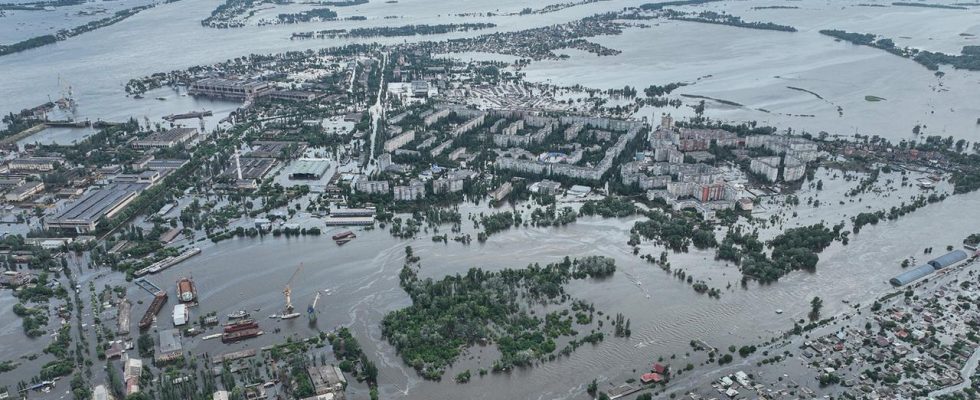report
The Kachowka Dam in Ukraine held 18 billion cubic meters of water – until it was destroyed. Fuel and lubricants spilled into the rivers. Fish inspector Polchovksyi warns of the ecological consequences – also for Europe.
About a month and a half after the obviously wanton destruction of the Kakhovka dam, the water of the Dnipro has drained away about 80 kilometers downstream in Cherson and the surrounding area. The ecological inventory is still in progress, but for Volodymyr Polchovksyi the first fears have not been confirmed, at least so far, there has been no mass death of fish in his area. In some tributaries of the Dnipro, the water level has dropped slightly, but so far it has not been critical for the stock.
The fish inspector is in his early 30s and works for the Kherson region. He monitors what are known as aquatic bioresources, i.e. stocks of pike, carp, tench and crayfish in the water-rich Black Sea region.
The Kherson regional military administration has continued to ban fishing and fisherman sales due to pollutants and untreated water leaking into rivers and lakes. Eating the fish could endanger human health. That’s why the fish inspector and his teams are also on the hunt for illegal anglers and poachers.
So far there has been no mass death of fish, but fish inspector Volodymyr Polchovksyi is concerned.
Flooded landfill
It’s worse upstream. Farmers there are complaining about dried-up fields and millions in losses. Fish inspector Polchovskyi is standing on the bank of the small Kosheva River in Cherson and is talking about his work when he is abruptly interrupted by loud artillery. The Russian continuous shelling of the region has not stopped. “It’s always noisy here,” he continues, unperturbed, while both Ukrainian and Russian artillery can be heard.
After the destruction of the Kakhovka dam at the beginning of June, the mighty Dnipro flooded the region, which is rich in rivers and lakes, uncontrollably. The village of Belozerka was also badly flooded, says the inspector, pointing to the opposite bank in the direction of the village. A garbage dump in the area was completely flooded at the time. Just like the sewage treatment plants that would normally purify the water from drainage pits. As the water gradually sank, everything flowed into the Dnipro. “You can’t see the rubbish, everything is already in flux,” he says matter-of-factly.
Concern for ecological balance
The life-threatening flood on June 6 of this year also woke Polchovskyj up. He stayed at his dacha by the river and helped with the first evacuations of panicked people. At the same time, he feared for the highly sensitive ecological balance in his region. “If even small amounts of fertilizers containing nitrogen and ammonia get into the water, it will kill off aquatic bioresources.”
According to his observations, there has not yet been a fish kill in the Cherson region. Although some tributaries of the Dnipro have less water, this is not critical, according to the inspector.
An employee of the Cherson water works repairs dilapidated pipes.
Devastated fields and million losses for farmers
Vadim Sheremet takes a different view. He walks furiously over his devastated fields in Pavlo-Marynivka in the Mykolaiv region. The aftermath of the catastrophic flooding is yet another of many problems facing the farmer. Mined fields, price slumps and export problems for his grain also weigh on him. “We have no harvest from this crop, we have to sow and wait for the next harvest,” says Sheremet. “We are losing millions. Farmers in Ukraine are losing millions of dollars.”
Pavlo-Marynivka is located on the Inhulets, a tributary of the Dnipro. In early June, this not only flooded fertile grain, vegetable and strawberry fields along its course, but also plants and animals in decades-old nature reserves in the region, says fish inspector Polchovskyi.
At the same time, the war goes on. In Cherson, the Dnipro is also the front line. Since the recapture in November, the city has been shelled more than 4,000 times by the Russian side. According to the regional military administration, more than 370 people were injured and at least 135 died. They stood at bus stops, went shopping at the market or were shot at while evacuating from the life-threatening flood.
Extent of ecological damage still unclear
According to the fish inspector, when Kherson was liberated and Russian troops withdrew, the areas of the seaport, river port and parts of the shipyard, where the fleet and large steamships were located, were blown up and flooded.
Fuel and lubricants have spilled into the river and it is still very difficult to assess the extent of the ecological damage. But he is certain: “It doesn’t just affect Ukraine and the Cherson region. All of this will reach the shores of Europe.”
Polchovskyi lets his gaze wander along the banks of the Koshva River near Cherson. Opposite there was shelling from the Russian side in the morning, says the fish inspector. Like everyone in this area, he lives dangerously. Nevertheless, he continues his work.

